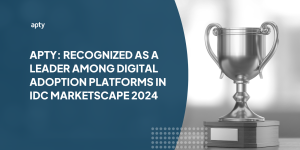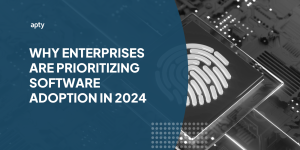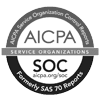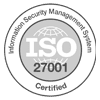Organizational adaptability has become crucial in the current global scenario, especially highlighted by the challenges and shifts brought on by the COVID-19 pandemic. Changes are constant and can span a broad spectrum, including leadership restructuring, onboarding new team members, policy updates, or adopting and integrating new technologies.
The necessity for change is ingrained in the fabric of organizational operations, yet handling change ineffectively can severely hinder an organization’s progress. Initiating and managing change within enterprises poses significant challenges, but successful execution can substantially enhance business performance, setting your organization apart from competitors by fostering a smooth and efficient change management process.
With the increasing acceptance of remote work, organizations are now tasked with implementing remote working protocols, necessitating adjustments in business operations. Additionally, there’s a noticeable growth in change management sophistication across various industries. Today’s organizational cultures have embraced digitization more fully than ever, making adept change management a linchpin for organizational resilience and growth. This discussion focuses on:
- Identifying common obstacles in change management
- Outlining best practices for successful change management
- Providing steps to develop a robust change management strategy
Read More: 7 Organizational Change Management Strategies
Why Change Management is Indispensable for Software Implementation Success
As enterprises increasingly adopt Software as a Service (SaaS) platforms, transitioning from traditional systems to these advanced solutions is not challenging. This shift underscores the vital importance of change management—a strategic approach crucial for addressing risks and maximizing the benefits of digital investments.
Ensuring Smooth Transitions
Change management is a crucial bridge, facilitating a smooth transition to modern SaaS solutions. Beyond technology upgrades, this process focuses on supporting people through change. Effective change management strategies involve comprehensive planning to smoothly introduce new tools and processes, aiming to sustain productivity and morale without disrupting daily operations.
Promoting User Adoption with Focused Strategies
Achieving high user adoption rates is key to the success of any SaaS implementation. Change management addresses this by prioritizing the end-user experience, ensuring that new systems are accessible and user-friendly. Organizations can identify and alleviate potential challenges through tailored training, support, and feedback mechanisms, fostering a culture of continuous improvement.
Guaranteeing Operational Continuity
A significant concern with new technology adoption is maintaining uninterrupted business operations. Through careful planning, phased deployments, and cross-departmental coordination, change management minimizes downtime and ensures a unified progression across the organization, preventing operational silos.
Achieving Strategic Alignment
SaaS platforms offer extensive customization, which, without careful oversight, could detract from business goals. Change management ensures that customizations are purposeful, enhancing functionality without adding unnecessary complexity. This strategic oversight ensures that technological investments directly support the organization’s objectives.
Prioritizing Security
The move to SaaS introduces complex security challenges. A comprehensive change management approach instills a culture of security awareness, extending beyond the IT department to empower all users in protecting sensitive information. This organization-wide commitment to security is critical for mitigating risks in the digital landscape.
Driving ROI and Gaining a Competitive Edge
The ultimate aim of change management in SaaS initiatives is to fully leverage new technologies to achieve business objectives. It’s about more than just a successful deployment; it’s ensuring that these tools contribute to operational efficiency, innovation, and customer satisfaction, thereby offering a substantial competitive advantage.
Change management is indispensable in the journey towards SaaS adoption. It translates technological investments into real-world advantages, championing a culture of innovation and continuous improvement. Through strategic planning, user-centric approaches, and a commitment to security, enterprises can successfully navigate the complexities of digital transformation, securing a robust and resilient future.
Relevant Read: How to Build a Fool-proof Change Management Plan with Apty DAP
Understanding the Risks of Failed Software Change Management
Transitioning to SaaS platforms can significantly impact an organization’s operational efficiency and innovation capacity. However, the journey is fraught with challenges, notably when change management falls short of addressing the needs and concerns of its workforce. This inadequacy can trigger a series of adverse outcomes, emphasizing the necessity of a well-structured change management strategy.
A. Neglecting User Training and Support
A lack of comprehensive training and support for users during a SaaS implementation can lead to widespread confusion about the new system’s functionality. Without proper guidance, employees may not use the system as intended, resulting in operational inefficiencies such as incorrect data entries, processing errors, and, ultimately, a decline in customer satisfaction.
Training and support are crucial to ensure that all team members are competent and confident in using the new system, highlighting the importance of these elements in change management.
B. Operational Disruption and Productivity Loss
Inadequate change management can significantly disrupt daily operations, leading to a decrease in productivity. When employees face challenges adapting to new workflows without clear guidance or sufficient customization to their needs, the transition period becomes prolonged and fraught with errors.
This situation can strain internal processes and negatively impact the quality of service or products offered to customers, emphasizing the need for well-structured change management that aligns with the organization’s and its workforce’s specific requirements.
C. Underestimating the Cultural Shift
Implementing a new SaaS solution often requires a shift in workplace culture and habits, a change that can be met with resistance if not managed properly. Failing to address the cultural and behavioral changes necessary for the successful adoption of new technologies can hinder the organization’s ability to fully realize the benefits of the SaaS platform.
Effective change management must, therefore, include strategies to engage employees, encourage adaptability, and foster a culture of continuous learning and innovation.
D. Security Risks
Transitioning to a SaaS platform without a robust change management strategy poses security risks. Employees unfamiliar with the new system’s security features or best practices for data protection may inadvertently expose the organization to data breaches and compliance issues.
Regular training on data security, clear communication about the importance of compliance, and stringent monitoring during the transition are essential components of a comprehensive change management plan.
E. Impact on Return on Investment (ROI)
Finally, inadequate change management can affect the ROI of the SaaS solution. Without ensuring that the workforce can fully leverage the new system’s capabilities, the organization may not achieve the expected efficiency gains or competitive advantages, making the investment less fruitful. A successful change management strategy ensures that the organization explores and exploits the full spectrum of the SaaS solution’s capabilities, turning every feature into a functional benefit that contributes positively to the bottom line.
The risks associated with inadequate SaaS change management vary significantly, affecting everything from employee productivity and operational efficiency to security and financial outcomes. Recognizing and addressing these risks through comprehensive, user-focused change management strategies is crucial for any organization aiming to successfully navigate the complexities of SaaS implementation.
Learn more: 15 Change Management Questions to Ask
Change Management Challenges
Understanding that approximately 70% of change initiatives do not achieve their goals underscores the importance of meticulous planning and execution in change management efforts. Recognizing and preparing for potential challenges is key to navigating this complex landscape successfully.
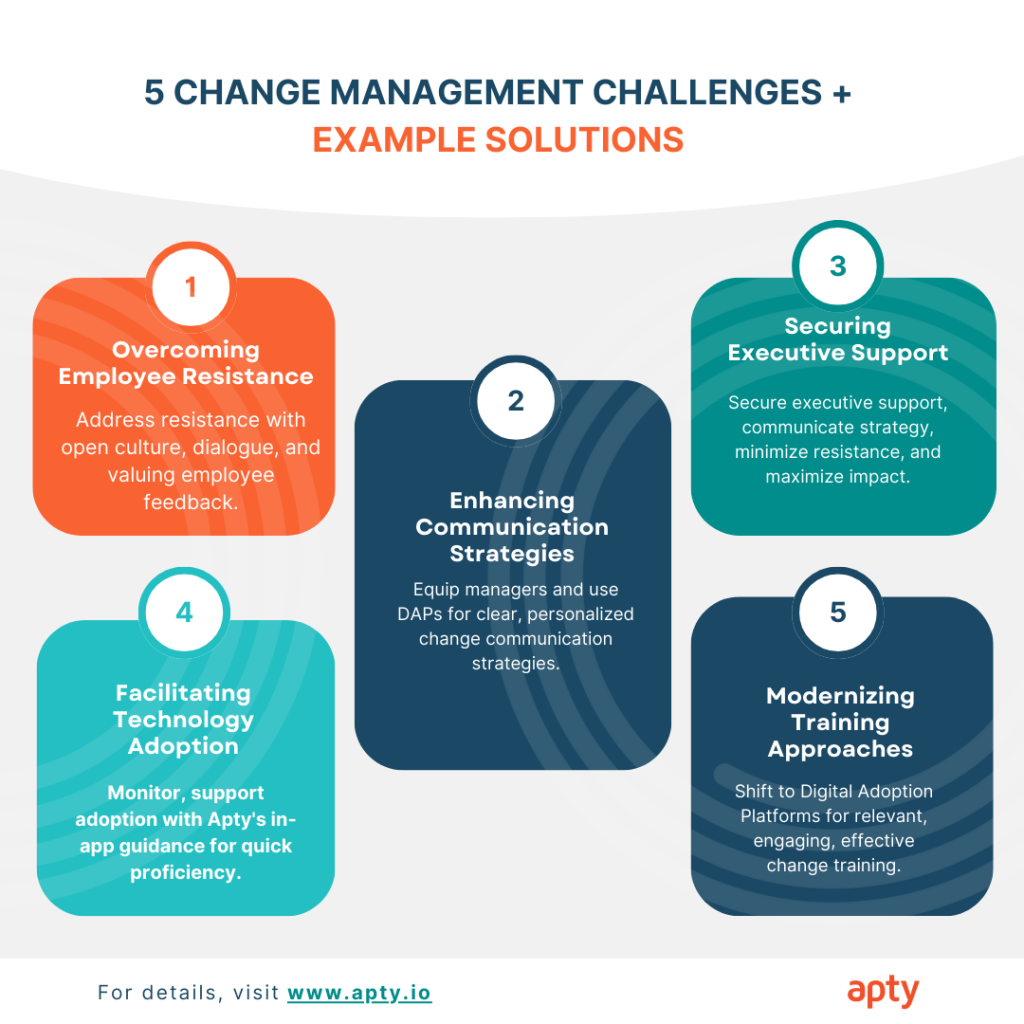
1. Overcoming Employee Resistance
Resistance from employees emerges as a primary challenge in organizational change. This resistance can manifest in various forms, from overt opposition to subtler, passive-aggressive behaviors. Often rooted in fear of the unknown or discomfort with new learning curves, resistance signals a deep level of care and concern among employees about the organization’s future.
Addressing resistance effectively involves fostering an open culture that values feedback and communication. Encouraging dialogue and addressing concerns directly can transform resistance into a constructive force, galvanizing engagement and commitment to change.
2. Enhancing Communication Strategies
Effective communication is crucial to successful change management. However, achieving seamless communication across all levels of an organization can be challenging due to silos and bureaucratic hurdles. Ensuring managers are equipped to articulate the rationale and objectives behind changes.
Leveraging Digital Adoption Platforms (DAPs) can revolutionize how changes are communicated, offering personalized, application-based learning experiences that resonate with employees’ daily tasks. This approach ensures clarity and consistency in messaging, bridging the gap between intention and perception.
3. Securing Executive Support
The success of change initiatives often hinges on active and visible support from top executives. A lack of executive engagement can signal to employees that the change is not a priority, potentially undermining the initiative’s credibility and resources.
Cultivating executive buy-in through clear communication of the change’s strategic importance can secure the necessary resources and support, minimizing resistance, and maximizing the initiative’s impact.
4. Facilitating Effective Technology Adoption
The heart of many change initiatives is the adoption of new technologies. However, the transition can falter if employees do not embrace and effectively utilize these tools. Monitoring and supporting the adoption process is vital to realize the full benefits of the change.
Digital Adoption Platforms like Apty offer an innovative solution by providing real-time, in-app guidance that accelerates learning and adoption, enabling employees to quickly become proficient with new technologies without extensive off-the-job training.
5. Modernizing Training Approaches
Traditional training methods often fall short in facilitating the rapid adoption of change. Generic, classroom-based training can disconnect employees from their work context and overwhelm them with irrelevant information.
A shift towards digital adoption platforms as a training tool can dramatically improve training effectiveness. By offering tailored, on-demand guidance directly within the applications employees use, these platforms ensure that training is relevant, engaging, and directly applicable to daily tasks, significantly enhancing change initiatives’ adoption rate and overall success.
Anticipating these challenges and strategically addressing them, organizations can greatly improve the success rate of their change management initiatives, ensuring smoother transitions and stronger alignment with long-term goals.
4 Top Strategies for Excellence in Organizational Change Management
Research by CFO Innovation highlights that organizations with robust change management practices are 2.5 times more likely to surpass their competitors. A well-structured strategy is essential to navigate the complexities of change management successfully.
Relevant Read: Organizational Change Management Plan
Here are some best practices you can follow for effective organizational change management:
i. Enhancing Transparency
Transparency stands as a cornerstone in mitigating resistance to change. Without clear communication, employee misconceptions about the impact of change can proliferate. Prioritizing open, consistent communication throughout the change process is vital. Engage with employees early, addressing their concerns and encouraging their input. This involvement is crucial as it prepares them for the upcoming change and plays a significant role in the change’s success.
Educating employees about the necessity of the change and its implications and providing them with the necessary resources ensures they are well-prepared for the transition.
ii. Articulating the Business Case
When introducing a change initiative to stakeholders, presenting a compelling business case is imperative. This case should outline the change’s rationale, anticipated benefits, and expected outcomes. Answering the key questions—what the change entails, its purpose, the stakeholders involved, and the resources required—is critical to garnering support from decision-makers. This clarity aids in securing the necessary budget and resources for the initiative.
To build an effective business case for your change initiative, you need to answer four key questions:
- What is the change project?
- What is the reasoning behind it? What are the benefits, values, and expected outcomes of this change?
- Who are the decision-makers that must be convinced?
- What resources and personnel are needed for this change?
Build the business case for the change and use it to get a clear idea of how you can communicate it to top-level executives and convince them to allocate the necessary budget and resources for the project.
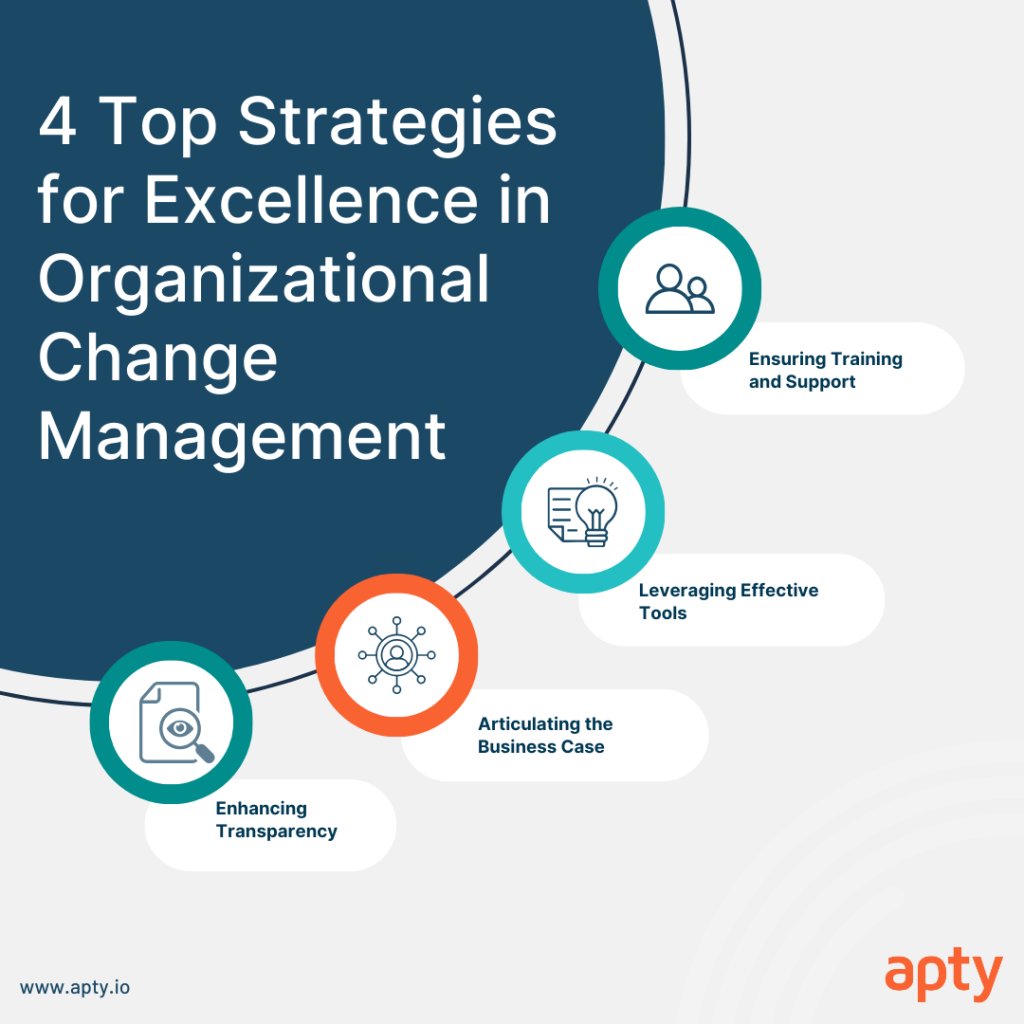
iii. Leveraging Effective Tools
Identifying the right tools is a critical component of your change management strategy, encompassing:
- Planning and project management
- Communication
- Training and Support
- Analytics
Evaluate your current toolkit and consider whether additional resources are needed to bolster your change management efforts. Platforms like Apty can significantly support communication, training, and analytics, facilitating smoother adoption of new technologies and processes.
Relevant Read: Driving Digital Transformation Through Software Adoption
iv. Ensuring Continuous Training and Support
Recognizing that change is a process, not a one-time event, is crucial. Overcoming the “forgetting curve”—the rapid loss of learned information—is a major challenge in training and change management. Continuous support and training are necessary to reinforce learning and encourage the adoption of new processes or software.
Digital Adoption Platforms (DAPs) like Apty offer a solution by directly providing on-demand access to training materials within the application environment. This approach is a central repository for learning content, significantly reducing the time and costs associated with training and support and ensuring that employees remain engaged and informed throughout the change process.
Adopting these strategic best practices, organizations can effectively address the challenges of change management, fostering an environment conducive to growth, innovation, and sustained competitive advantage.
How Apty Facilitates Change Management for Enterprise Software
A. Boosting Employee Engagement and Minimizing Resistance
Apty transforms how employees adapt to new software, enhancing efficiency with its intuitive contextual walkthroughs and tooltips. By integrating Apty, organizations can significantly accelerate software adoption rates. Fortune 500 companies trust Apty for their change management and digital adoption strategies.
Apty’s seamless on-screen guidance ensures every employee can master new software and processes effortlessly. This direct support mechanism not only facilitates quicker adoption but also alleviates the workload on IT departments by providing an in-app help desk with all necessary resources readily available, thus significantly diminishing miscommunication and resistance among staff.
B. Ensuring Compliance with Business Processes
Adherence to internal and external regulations and policies is critical across all industries. Apty supports organizations in maintaining compliance with these standards through innovative features. Its data validation tools guarantee the accuracy and integrity of data entry, while activity tracking offers a detailed audit trail of software interactions, prioritizing user privacy.
Moreover, Apty’s workflows and tooltips guide employees in accurately following intended processes. The platform’s announcement capabilities are instrumental in effectively communicating policy changes, proving more efficient than traditional email notifications by ensuring employees acknowledge and incorporate critical updates.
C. Streamlining Operations through Automation
Automation stands as a key driver in optimizing efficiency and reducing repetitive tasks. Apty’s advanced AI capabilities, including its chatbot, allow for the automation of routine tasks, freeing employees to focus on more strategic and fulfilling work.
This functionality enhances productivity and improves employee satisfaction by minimizing the monotony of daily tasks. When an employee needs to complete a specific action, the chatbot simplifies the process, requiring only essential information.
D. Enhancing Training and Support
Ongoing training and support are paramount for the success of any change initiative. Apty champions on-the-job learning through on-screen guidance, enabling micro-learning—short, focused training sessions that enhance engagement and retention, countering the forgetting curve.
Apty’s approach to training is designed to seamlessly integrate learning into the workflow, thereby minimizing productivity loss and significantly cutting training and support expenses by up to 80%. The platform’s in-app help deck provides instant access to walkthroughs and learning materials, ensuring employees have the resources they need when they need them.
E. Facilitating Effective Change Communication
Clear, consistent communication is crucial throughout the organizational change process. Apty’s announcement feature optimizes how changes are conveyed to employees, enabling customization to guide users through new processes via interactive walkthroughs. This tool ensures that important updates are not overlooked, reminding employees to engage with new procedures.
Navigating organizational change is inherently challenging and fraught with potential obstacles and setbacks. Apty’s digital adoption platform streamlines the execution of change programs, enhancing the adoption of new processes and technologies while reducing associated costs. With Apty, organizations are equipped to embrace change, making it an indispensable tool for modern change management strategies.

